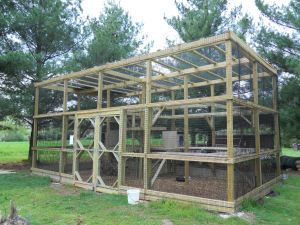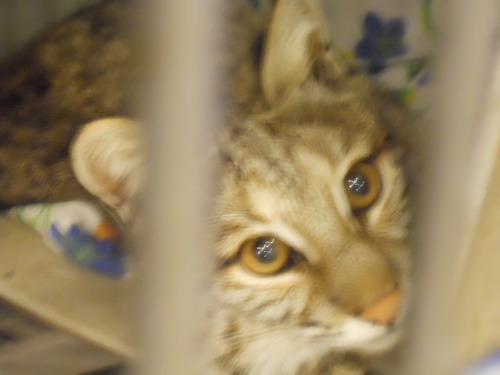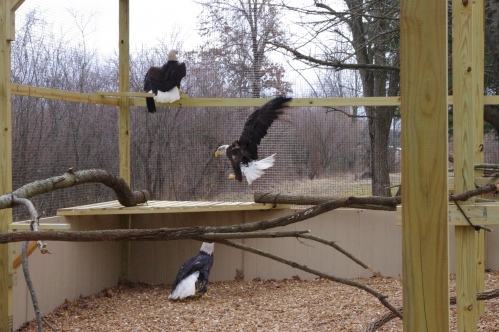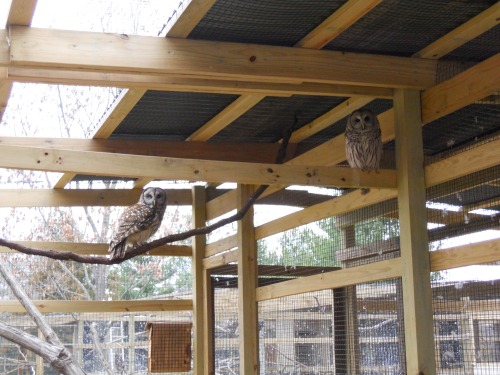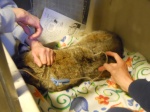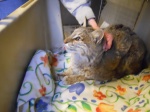This weekend, Lisa the bird behaviorist came back to TreeHouse for her second session working with Einstein. We’ve spent the last few weeks practicing the behaviors we started working on the first time she came—getting him to go to one particular perch before we enter his cage and then “targeting” to various locations around his cage. We’ve also worked a little bit on “eagle,” which is asking him to spread out his wings. In order to teach him this behavior, we wait for him to do it naturally (usually when he is trying to regain his balance on a swinging perch) and then mark the behavior by clicking the clicker and saying something like, “Good bird! Eagle.” He has now done the “eagle” behavior on command a few times, but it is something we’ll have to continue to work on in order to get some consistency.
During this session with Lisa, our plan was to work on getting him to go into a crate of his own accord. If we can teach him to crate up on command, volunteers will be able to go into his cage to clean without worrying about him harassing them, and we will be able to pack him up to go to events like booths and educational programs while eliminating the stress that accompanies being captured and forcibly placed in a crate. The door of the crate will be modified with a magnet to hold it closed, and, ideally, we will eventually train Einstein to swing the door shut himself.
When Lisa first introduced the crate into Einstein’s cage, his reaction was totally unexpected. In the past, he has shown a high level of curiosity about new items in his cage. But as soon as Lisa set the crate down, Einstein reacted with what we can only interpret as terror—he immediately fled to his highest perch, and from there proceeded to fly around the cage, crashing into the mesh that creates a barrier in front of the glass and only barely avoiding flying out the door of his cage. (Interestingly, it appeared intentional that he did not fly out the door—he veered to the side at the last second. He definitely knows his boundaries—more about that later.) I had never seen him panic like this. Some of the other birds do regularly fly into the mesh on their cage walls, but not Einstein. He knows where his cage ends, and he seems to realize that trying to get through is futile.
The intensity of his reaction to the crate leads us to believe that he has had some kind of strong negative experience with a crate. Most likely, the people who kept him as a baby (and on whom he imprinted) kept him in a crate like this. Even if he wasn’t really mistreated, if he was kept in the crate and rarely or never let out, it could create the kind of strong negative association we saw. Turkey vultures are highly intelligent animals with long memories.
We spent the rest of the session trying to get Einstein acclimatized to the presence of the crate. After seeing his initial reaction, Lisa cautioned that we may ultimately find that our original goal of teaching Einstein to shut himself in of his own volition may be untenable. Still, we certainly weren’t ready to give up yet.
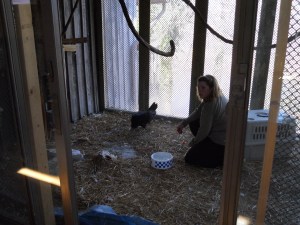
Marcie trying to get Einstein to come closer to the crate.
At first, Einstein wouldn’t do anything. We tried to work on his old exercises, but he just stayed on one perch, watching the crate out of the corner of his eye. He actually wouldn’t turn his back on it, but he wouldn’t really look directly at it, either. Finally, Marcie, the woman who originally contacted Lisa, got Einstein to target to her on the floor by holding out a treat very near the base of the perch on which he was standing.
After that, it was a gradual process of bringing the target progressively closer to the entrance of the crate. Eventually, we were able to crouch on the side of the crate and hold the target stick right in front of the crate’s opening, and Einstein would come right to the edge of what he evidently saw as some horrible dark abyss to take the treat. Still, immediately after grabbing it, he would beat a hasty retreat back to the opposite corner.
We also attempted to reassure him that the crate was not a threat by touching it to show that it wasn’t dangerous while saying things like, “It’s OK, Einstein.” As a human imprint, Einstein, at least to some extent, takes behavioral cues from humans, so if we show him that we are not alarmed by the crate, he may see that it is nothing to be afraid of. For now, we are going to be leaving the crate in his cage for a few hours every day to allow him to get used to it without stressing him excessively by its constant presence.
At the end of the session, while all the vulture handlers were standing outside Einstein’s cage talking, he did the funniest—and coolest—thing I’ve ever seen him do. We had left the cage door open and had not yet taken the crate out of the cage—we wanted to see if he would investigate it if left to himself. After a few minutes of poking around, he came to the cage door. We often leave the door open when working with him, because we go in and out of the cage many times. He never crosses the threshold. As I mentioned earlier, he knows his boundaries. There is a metal track for the sliding door, and I’m not sure whether he’s afraid of it, or it hurts his feet, or what exactly the reason is, but he never crosses it.
This time, though, he really wanted to be a part of the gathering that was happening outside his cage. After standing there for a moment watching us, he started tugging at the rug that’s outside the door. He’s done this before, so I didn’t really think anything of it—until he pulled the corner of the rug over the threshold and used it as a bridge. He then stepped into the middle of the rug and looked around at all of us as if to say, “I’m here—what are we all doing?” He never stepped off the rug, but after a couple of minutes he started tugging at my jeans, and Lisa marshaled him back into his cage. The whole thing was pretty unbelievable.
This slideshow requires JavaScript.
It’s likely to take a while before Einstein is actually willing to enter the crate. If we try to force him into it, we’ll only undo all the work we’ve done. Still, it will be worth it, and anyway he’s so fascinating to work with that none of us mind the extra time we spend with him.
